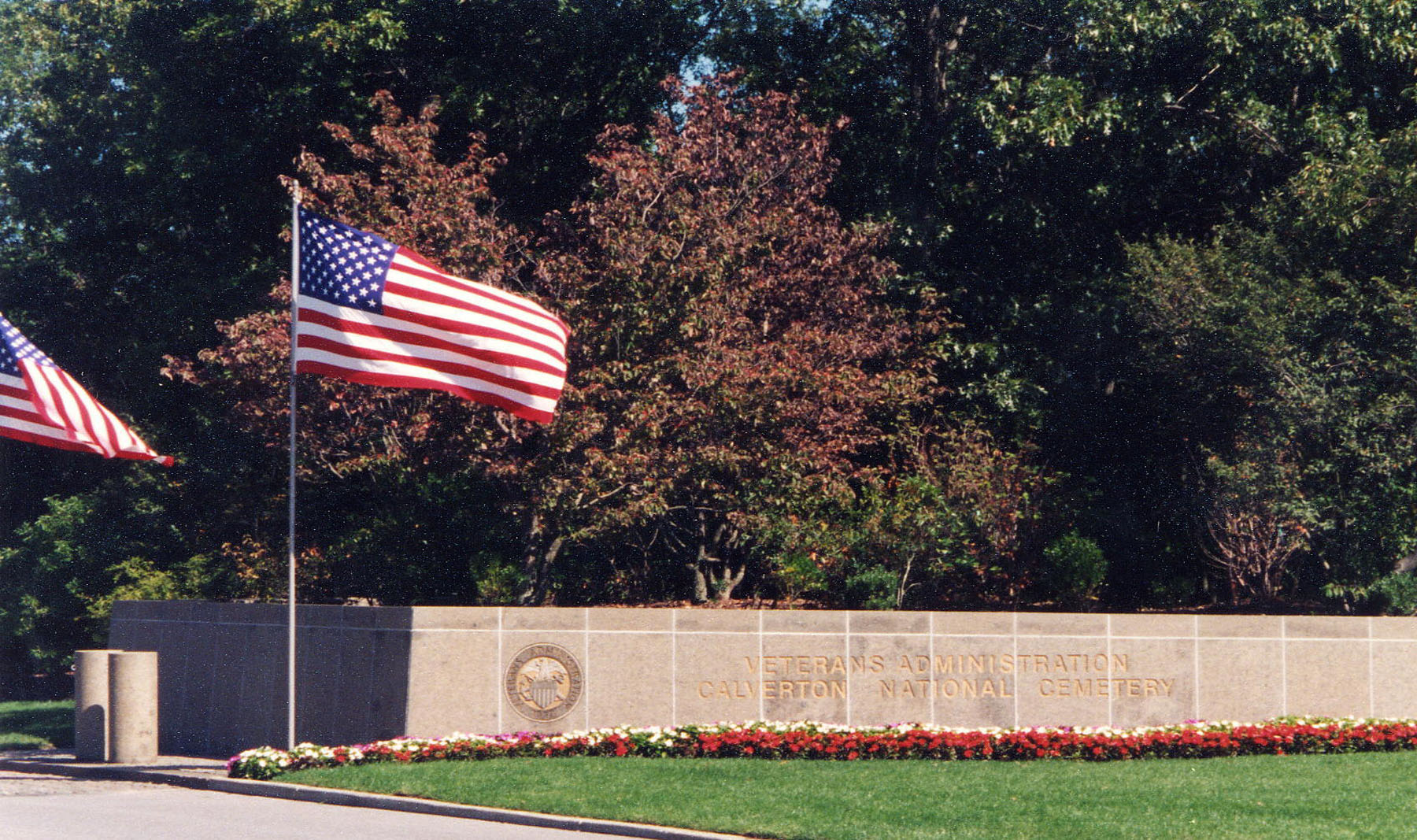Calverton National Cemetery
210 Princeton Boulevard
Calverton, NY 11933-1031
Phone: (631) 727- 5410
FAX: (631) 369- 4397
|
Office Hours:
Monday through Friday 8:00 a.m. to 4:30 p.m.
Open all holidays except Independence Day, Thanksgiving, Christmas and New Year's Day.
Visitation Hours:
Open daily from sunrise to sunset.
|

|
Burial Space: This cemetery has space available to accommodate casketed and cremated remains.
Acreage: 1,045
Number of Interments
Thru Fiscal Year 2008: 207,719
General Information Kiosk on Site? Yes
Floral/Ground Regulations
|
Directions from nearest airport:
There are three airports on Long Island. The nearest is Long Island MacArthur Airport in Islip and travel time to the cemetery is about 30 minutes. JFK and LaGuardia are at least 80 minutes away in good traffic. The cemetery is about 70 miles from New York City, making travel time approximately 90 minutes in local area traffic. Take the Long Island Expressway (495) to Exit 68 (William Floyd Parkway). Then take William Floyd Parkway, north four miles to Route 25. Take route 25 east for approximately four miles. The cemetery entrance is on the left.
|
GENERAL INFORMATION
Grave Location:
The grave location of your loved one is furnished on the map included in the burial document folder. There is a gravesite locator in the administration building for those who may not know the location of the gravesite. The cemetery office personnel are available to assist visitors during office hours.
Grave Marker:
A temporary grave marker is used to mark the grave following the interment. A permanent grave marker will be furnished free of charge by the Government without application from the family. Every effort is made to have the grave marker delivered and set within 60 days from the day of interment.
Grounds Maintenance:
Immediately after each interment, the grave is filled and leveled and may require repeated renovation. Matters that appear to need immediate corrective action should be brought to the attention of the cemetery office personnel.
Flags:
The United States flag is flown over national cemeteries every day. Graves are decorated annually with United States gravesite flags the Saturday before Memorial Day and are removed the Saturday after the holiday. Flags are not permitted on graves at any other time.
back to top
HISTORICAL INFORMATION
Calverton National Cemetery is located in eastern Long Island between the towns of Manorville and Riverhead in Suffolk County. When the National Cemetery System constructed Calverton National Cemetery in 1978, the cemetery became the third national cemetery to be located on Long Island. The other national cemeteries situated on Long Island are Cypress Hills National Cemetery, in Brooklyn, N.Y., which was established in 1862 and Long Island National Cemetery, in Farmingdale, N.Y., established in 1936.
In 1974, Long Island National Cemetery was the only national cemetery on Long Island with available space for burials--but its maximum burial capacity was soon to be exhausted. As a result, plans were developed by the National Cemetery System to construct a new regional cemetery to serve the greater New York area—home, then, to nearly three million veterans and their dependents. On Dec. 7, 1977, a 902-acre tract of land was transferred from the U.S. Naval Weapons Industrial Reserve Plant at Calverton to the Veterans Administration for use as a national cemetery.
The National Cemetery System realized that Calverton National Cemetery would become one of its more active cemeteries. For that reason, they designed and built a feature called a committal “wheel” of shelters that permits multiple burial services to be held simultaneously. To the left of the main cemetery entrance, around the Veteran’s Circle, are seven committal shelters. After the funeral service, the caskets are moved into the hub of the wheel and then transported to their respective gravesites. One floral arrangement is taken to the gravesite. In 1983, the walls of the committal shelters were reconstructed to serve as columbaria for the inurnment of cremated remains. Calverton is the largest, and one of the most active national cemeteries currently overseen by the National Cemetery Administration.
Monuments and Memorials
Calverton National Cemetery features a memorial pathway lined with a variety of memorials that honor America's veterans. As of 2007, there are 17 memorials here, most commemorating soldiers of 20th century wars.
back to top
NOTABLE PERSONS
Medal of Honor Recipients
Lieutenant Michael P. Murphy, (Afghanistan), U.S. Navy, Operation Redwing, Afghanistan, June 28, 2005 (Section 67, Grave 3710).
back to top
FLORAL/GROUNDS REGULATIONS
Cemetery policies are conspicuously posted and readily visible to the public.
One floral arrangement accompanying the casket or urn at the time of burial will be placed on the completed grave. Natural cut flowers may be placed on graves at any time of the year. They will be removed when they become unsightly or when it becomes necessary to facilitate cemetery operations such as mowing.
Artificial flowers and potted plants will be permitted on graves during periods when their presence will not interfere with grounds maintenance. As a general rule, artificial flowers and potted plants will be allowed on graves for a period extending five days before through five days after Easter Sunday and Memorial Day.
Christmas wreaths, grave blankets and other seasonal adornments may be placed on graves from Dec. 15 through Jan. 15. They may not be secured to headstones or markers.
Permanent plantings, statues, vigil lights, breakable objects and similar items are not permitted on the graves. The Department of Veterans Affairs does not permit adornments that are considered offensive, inconsistent with the dignity of the cemetery or considered hazardous to cemetery personnel. For example, items incorporating beads or wires may become entangled in mowers or other equipment and cause injury.
Permanent items removed from graves will be placed in an inconspicuous holding area for one month prior to disposal. Decorative items removed from graves remain the property of the donor but are under the custodianship of the cemetery. If not retrieved by the donor, they are then governed by the rules for disposal of federal property.
back to top
|


